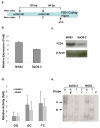Functional and association analysis of frizzled 1 (FZD1) promoter haplotypes with femoral neck geometry
- PMID: 20051274
- PMCID: PMC2842476
- DOI: 10.1016/j.bone.2009.12.026
Functional and association analysis of frizzled 1 (FZD1) promoter haplotypes with femoral neck geometry
Abstract
Frizzleds are receptors for Wnt signaling and are involved in skeletal morphogenesis. Little is known about the transcriptional regulation of frizzleds in bone cells. In the current study, we determined if two common and potentially functional genetic variants (rs2232157, rs2232158) in the frizzled-1 (FZD1) promoter region and their haplotypes influence FZD1 promoter activity in human osteoblast-like cells. We also determined if these variants are associated with femoral neck bone mineral density (BMD) and geometry in 1319 African ancestry men aged > or =40 years. Real-time quantitative PCR and western blot analysis demonstrated FZD1 mRNA and protein expression in the human osteoblast-like cell lines, MG63 and SaOS-2. Promoter activity was next assessed by transient expression of haplotype specific FZD1 promoter reporter plasmids in these cells. In comparison to the common GG haplotype, promoter activity was 3-fold higher for the TC haplotype in both cell lines (p<0.05). We previously demonstrated that rs2232158 is associated with differential FZD1 promoter activity and Egr1 binding and thus focused further functional analyses on the rs2232157 G-to-T polymorphism. Electrophoretic mobility shift assay demonstrated that distinct nuclear protein complexes were associated with rs2232157 in an allele specific manner. Bioinformatics analysis predicted that the G to T transversion creates an E2F1 binding site, further supporting the functional significance of rs2232157 in FZD1 promoter regulation. Individual SNPs and haplotypes were not associated with femoral neck BMD. The TC haplotype was associated with larger subperiosteal width and greater CSMI (p<0.05). These results suggest that FZD1 expression is regulated in a haplotype-dependent manner in osteoblasts and that these same haplotypes may be associated with biomechanical indices of bone strength.
Keywords: WNT; frizzled-1; haplotype; osteoblast; osteoporosis.
Copyright 2009 Elsevier Inc. All rights reserved.
Figures

Similar articles
-
E2F1 effects on osteoblast differentiation and mineralization are mediated through up-regulation of frizzled-1.Bone. 2013 Oct;56(2):234-41. doi: 10.1016/j.bone.2013.06.019. Epub 2013 Jun 24. Bone. 2013. PMID: 23806799 Free PMC article.
-
Transcriptional Regulation of Frizzled-1 in Human Osteoblasts by Sp1.PLoS One. 2016 Oct 3;11(10):e0163277. doi: 10.1371/journal.pone.0163277. eCollection 2016. PLoS One. 2016. PMID: 27695039 Free PMC article.
-
Functional characterization of genetic variation in the Frizzled 1 (FZD1) promoter and association with bone phenotypes: more to the LRP5 story?J Bone Miner Res. 2009 Jan;24(1):87-96. doi: 10.1359/jbmr.080816. J Bone Miner Res. 2009. PMID: 18715140 Free PMC article.
-
A specific haplotype in potential miRNAs binding sites of secreted frizzled-related protein 1 (SFRP1) is associated with BMD variation in osteoporosis.Gene. 2018 Nov 30;677:132-141. doi: 10.1016/j.gene.2018.07.061. Epub 2018 Jul 25. Gene. 2018. PMID: 30055306
-
Non-association between polymorphisms of the frizzled receptor genes and bone mineral density in postmenopausal Korean women.J Korean Med Sci. 2009 Jun;24(3):443-7. doi: 10.3346/jkms.2009.24.3.443. Epub 2009 Jun 12. J Korean Med Sci. 2009. PMID: 19543507 Free PMC article.
Cited by
-
The landscape of GWAS validation; systematic review identifying 309 validated non-coding variants across 130 human diseases.BMC Med Genomics. 2022 Apr 1;15(1):74. doi: 10.1186/s12920-022-01216-w. BMC Med Genomics. 2022. PMID: 35365203 Free PMC article.
-
E2F1 effects on osteoblast differentiation and mineralization are mediated through up-regulation of frizzled-1.Bone. 2013 Oct;56(2):234-41. doi: 10.1016/j.bone.2013.06.019. Epub 2013 Jun 24. Bone. 2013. PMID: 23806799 Free PMC article.
-
Transcriptional Regulation of Frizzled-1 in Human Osteoblasts by Sp1.PLoS One. 2016 Oct 3;11(10):e0163277. doi: 10.1371/journal.pone.0163277. eCollection 2016. PLoS One. 2016. PMID: 27695039 Free PMC article.
-
The genetic pleiotropy of musculoskeletal aging.Front Physiol. 2012 Aug 8;3:303. doi: 10.3389/fphys.2012.00303. eCollection 2012. Front Physiol. 2012. PMID: 22934054 Free PMC article.
-
The role of GPCRs in bone diseases and dysfunctions.Bone Res. 2019 Jul 8;7:19. doi: 10.1038/s41413-019-0059-6. eCollection 2019. Bone Res. 2019. PMID: 31646011 Free PMC article. Review.
References
-
- Hartmann C. A Wnt canon orchestrating osteoblastogenesis. Trends Cell Biol. 2006;16:151–8. - PubMed
-
- Westendorf JJ, Kahler RA, Schroeder TM. Wnt signaling in osteoblasts and bone diseases. Gene. 2004;341:19–39. - PubMed
-
- Baron R, Rawadi G, Roman-Roman S. Wnt signaling: a key regulator of bone mass. Curr Top Dev Biol. 2006;76:103–27. - PubMed
-
- He X, Semenov M, Tamai K, Zeng X. LDL receptor-related proteins 5 and 6 in Wnt/beta-catenin signaling: arrows point the way. Development. 2004;131:1663–77. - PubMed
Publication types
MeSH terms
Substances
Grants and funding
LinkOut - more resources
Full Text Sources
Medical

